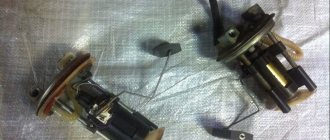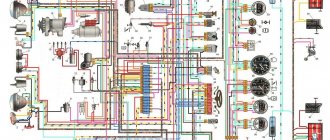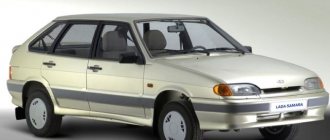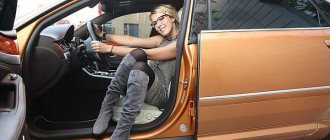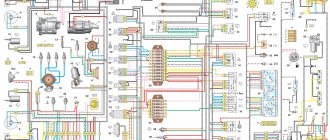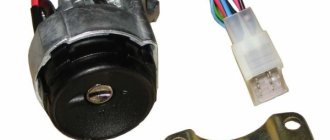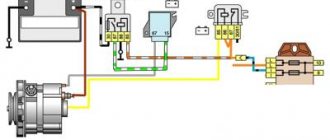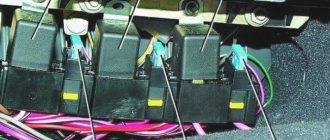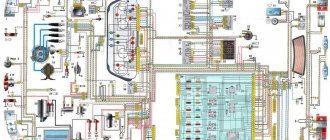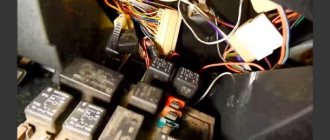Hello. Share a diagram of the parts and devices located under the hood.
- How to glue the hood reinforcement on a VAZ 2115? – 3 answers
- The amplifier has come off the hood of a VAZ 2115 - 3 answers
- Snow gets under the hood of a VAZ 2114 – 2 answers
- VAZ 2114 fuse diagram – 1 answer
- Icons on the instrument panel of the VAZ 2114 – 1 answer
In the center there is a motor, into which air flows through the receiver from the air filter, which is to the right of the engine. To the left of the engine is the windshield washer reservoir. The brake system hydraulic reservoir is located near the air duct above the air filter. The battery is in the lower right corner. The engine cooling system tank is installed slightly higher. The gearbox is located under the engine, under the right side.
Subscribe
to our channel in
Index.Zen
Even more useful tips in a convenient format
For the efficient operation of the injection power unit, the VAZ-2114 car system includes a large number of different mechanisms and automated devices. You can’t say that the “fourteenth” car is filled to capacity with electronics, but if you look under the hood, you can find all kinds of VAZ-2114 8-valve injector sensors.
The main purpose of electronics is to monitor the condition of vehicle components and assemblies. The received data is transmitted to the main “brain” center of the car. Thanks to this approach, the driver no longer needs to spend a long and exhausting time looking for reasons for deviations from the operation of a particular system. The ECU will provide all the information. What sensors are involved in the operation of the VAZ-2114 and where are they located?
General information about VAZ-2114 sensors
Sensors look like small mechanisms. However, their role in the operation of the entire vehicle system is simply colossal. They signal the remaining fuel in the gas tank, inform the driver of the coolant temperature, and determine the position of various engine elements in a certain operating mode. In order to know your car well and understand what could fail in a given situation, you need to know the entire list of mechanisms involved in the system.
We list all the sensors on the VAZ-2114 injector 8 valves, which are the most important:
- Crankshaft positions.
- TPDZ.
- Camshaft position sensor.
- DTOZH.
- Speed.
- Idle move.
- DMRV.
- Lambda probe.
These devices are in most cases located in the engine compartment. Almost all of them are installed at the factory during vehicle assembly. But the driver himself can install some sensors at any suitable time. It is also important to know how each of these devices works and what primary task it performs.
Device
An injector engine consists of several main elements. As in any car, fuel comes from the tank through the fuel line. Along the way, the combustible mixture goes through several stages of purification: a fine filter and a coarse filter. There is no strainer, such as was located on the carburetor inlet.
In general, on a VAZ car with an injector engine, instead of carburetor throttle valves, a throttle assembly is used. Its circuit is directly connected to the adsorber of the electromagnetic valves. It is he who regulates the fuel supply to the injectors.
As far as everyone knows, the correct operation of the engine directly depended on the amount of combustible mixture. It was controlled by the volume of the primary and secondary carburetor chambers, and the jets. In the version with an injector, a combination of three valves is used: two-way, safety and gravity. It is they who control that there is no overflow of the spark plug, or, conversely, a lack of fuel in the combustion chamber.
Fuel pressure control
In order for the engine to produce normal power and have synchronous operation of the valves, a fuel pressure regulator is installed in front of the injectors. With increased or decreased pressure, the regulator is activated, ensuring further operation of the piston.
Well, the last element of the device is the nozzles. They regulate injection into the combustion chamber. Since fuel is supplied to the injectors under constant pressure, they almost never clog. That is why the service life of a VAZ 2114 engine with an injector, without outside intervention, is much longer than with a carburetor.
In the period from 1999 to 2011, VAZ 2114 models with an injector engine were produced in two versions, which differed in engine capacity: 1500 and 1600 cm/cc. Their design was slightly different, not the circuit itself, but some components not related to the fuel system.
For example, the ignition system on a one and a half thousand engine has an ignition module, while on a 1600 cc engine a coil was installed.
Also, in addition to the above positive qualities of the injector, I would also like to note the reduced fuel consumption. For example, if a carburetor type engine consumed 10 liters per hundred, then the injector will take 8.5 - 9 liters. Therefore, if you have such an opportunity, then it is better to choose this type of engine. It may be more expensive, but remember: you are paying for personal comfort.
Crankshaft position sensor
You can often hear drivers with many years of experience calling this mechanism nothing other than a synchronization sensor. This name comes from the principle of operation of the device. The tasks of the DPKV are to synchronize the operation of the electronic unit and the gas distribution mechanism.
The VAZ-2114 is equipped with an inductive type DPKV. The cost of such a sensor is relatively small. If a vital controller for a car fails, most drivers prefer to immediately replace the device with a new one.
If the DPKV breaks down, further operation of the vehicle will become impossible. Without this mechanism, the fuel supply system will stop working, because the ECU will not receive information about when it is necessary to give a command to inject fuel into the cylinders. The location of the DPKV is in close proximity to the camshaft.
Electronics are responsible for fuel delivery in the VAZ-2114 car system. Without TPS, the control unit will not be able to determine the optimal time to supply gasoline. Deviations from the correct operation of the TPS lead to an increase in the amount of fuel consumed. The operation of many other car systems depends on the angle at which the remote control is located: cooling, fuel supply.
see also
The TPS is located near the idle speed sensor. In the “fourteenth” system, the work of these two devices is closely linked.
When the TPS breaks down, the car begins to twitch in a certain position of the damper, and instability of engine operation is also noted. All VAZ-2114 8 valve sensors are interconnected in their operation, so two different devices sometimes exhibit the same symptoms of malfunction. If symptoms of a breakdown occur, it is necessary to take a comprehensive approach to checking all controllers.
Another video with an example of replacement
The VAZ-2114 car uses a hidden engine cooling circuit with an injector. It is highly complex and includes 28 elements. Traditionally, the assembly of the cooling system of this car is not of high quality. Therefore, throughout the entire period of operation, it requires constant monitoring, regular maintenance and repair. In this regard, many owners of this car are interested in the nuances associated with independent maintenance, repair and operation of the cooling system, among which the most common questions are:
- 1. How to properly replace the coolant mixture?
- 2. How to flush the cooling system?
- 3. How to remove air from the VAZ-2114 cooling system?
- 4. How to properly replace the cooling system pipes?
Camshaft position sensor
This mechanism is located near the cylinder block. The main task is to transmit data to the ECU regarding the current operating cycle. Among specialists, the mechanism is called a Hall sensor. The operation of the device is based on the following principle: in accordance with the location of the crankshaft, the position of the gas distribution mechanism is determined. The data received by the sensor is reported to the electronic unit. Fuel is injected and the mixture is subsequently ignited.
Knock sensor, DTOZH, speed and others
In addition to the above mechanisms, other very important devices can be found in various corners of the engine compartment. The location of the VAZ-2114 injector sensors is quite chaotic, some are located directly on the power unit, others in other places - the gearbox, on electrical circuits.
Some equally important mechanisms include:
- The knock sensor is sensitive to various engine vibrations. Based on the received pulses, the ECU determines the qualitative composition of the mixture. Located on the cylinder block.
Engine temperature sensor - the only and simple, but extremely important task assigned to this device is to monitor the coolant temperature.
Speed sensor – from the name itself it is clear that this controller is necessary to measure the speed of a car. The DS transmits impulses to the ECU, which processes them and determines the speed of the car; the resulting result is displayed on the instrument panel by the speedometer.
Idling speed – not only reads information, but also corrects engine operation. DXH, using a special needle, controls the pipe - closes and opens. Due to this, the amount of oxygen supplied to the throttle assembly changes.
Mass air flow sensor - reads the data and transmits it to the control unit, which, based on the information received, determines the optimal ratio of the various components of the fuel-air mixture. A breakdown of the air flow sensor leads to the fact that the car significantly loses power, and the driver begins to feel a significant increase in the amount of gasoline consumed by the car.
Fuel system
It consists of many components: a fuel pump, a fuel pressure regulator, a fuel filter, a fuel line, injectors and a ramp, thanks to which fuel enters the engine. The ramp is a strip on which the injectors and fuel pressure regulator are located, and is attached with two bolts to the intake pipe. The injectors are mounted on the fuel rail, its function is to supply fuel to the engine. An injector is an electromagnetic valve that opens and sprays fuel under pressure in a thin stream after it receives a corresponding impulse from the ECU. Upon contact with the heaters, the fuel evaporates and is fed through the needle pin into the combustion chamber.
Car modifications 2114
VAZ-21140 . Modification with an 8-valve injection engine VAZ-2111, 1.5 liters and 77 horsepower. Serial production from 2003 to 2007
VAZ-21144 . Modification with an 8-valve VAZ-21114 engine, 1.6 liters and 81.6 horsepower. Years of serial production: 2007-2013.
VAZ-211440 . Another modification released in 2007, it was equipped with a VAZ-11183 engine with a volume of 1.6 liters and a power of 82 horsepower. The car was discontinued in 2013.
VAZ-211440-24 . Released in 2009, a modification with an injection 16-valve VAZ-21124 engine with a volume of 1.6 liters and a power of 89.1 horsepower. Discontinued in 2013.
VAZ-211440-26 . Modification with a 16-valve injection engine VAZ-21126, which complies with the Euro-3 environmental standard, with a volume of 1.6 liters and a power of 98 hp. The car was produced from 2010 to 2013.
Dimensions of Daewoo Nexia N150
Let's look at the dimensions of the four-door Daewoo Nexia sedan; they are the same for 8 and 16 valve cars (SOHC and DOHC, respectively). This car has five seats, a manual 5-speed transmission and front-wheel drive. Steering type: rack and pinion. The main body dimensions of the Daewoo Nexia N150 are as follows (indicated in millimeters):
- width – 1662;
- length – 4482;
- height – 1393;
- wheelbase – 2520;
- ground clearance (ground clearance) – 158;
- rear and front wheel track – 1406 and 1400;
- minimum turning radius – 4900.
Wiring diagram VAZ-2114 for old models
Electrical diagram of car 2114: 1 - headlight; 2 [Installed on a part of the car] - fog lamp; 3 — ambient air temperature sensor; 4 — electric engine radiator fan; 5 — block for connection to the wiring harness of the engine control system; 6 — engine compartment lamp switch; 7 [Installed on a part of the car] - reserve block for connecting an audio signal with one terminal (the negative terminal is connected to the body); 8 — sound signal; 9 — liquid level sensor in the windshield washer reservoir; 10 [Installed on a part of the car] - brake pad wear sensor; 11 — low oil level sensor; 12 - generator; 13 [Installed on a part of the car] - engine compartment lamp; 14 — temperature indicator sensor; 15 — starter; 16 — battery; 17 [Installed on a part of the car] - relay for turning on fog lights; 18 — coolant level sensor in the expansion tank; 19 — sensor of insufficient brake fluid level; 20 — reversing light switch; 21 — windshield wiper gear motor; 22 — emergency oil pressure sensor; 23 — rear window washer electric pump; 24 — electric pump for windshield washer; 25 — instrument panel; 26 — mounting block of fuses and relays; 27 — brake signal switch; 28 — ignition relay; 29 - ignition switch (lock); 30 — glove box lighting lamp; 31 — switch for the glove compartment lighting lamp; 32 — rear window heating switch; 33 — rear fog light switch; 34 [Installed on a part of the car] - fog light switch; 35 - combined switch for side lights and headlights; 36 — alarm switch; 37 — steering column switches; 38 — brightness control for instrument lighting; 39 — illumination lamp for the headlight hydraulic adjustment control handle; 40 — socket for connecting a portable lamp; 41 — side direction indicator; 42 — interior lighting switch (front door open sensor); 43 — interior lamp; 44 — electric fan of the ventilation and heating system; 45 — additional resistor of the electric fan of the ventilation and heating system; 46 — switch for operating modes of the electric fan of the ventilation and heating system; 47 — illumination lamp for the handle of the operating mode switch of the electric fan of the ventilation and heating system; 48 — backlight lamp for the heater control unit; 49 — display unit of the on-board control system; 50 [Installed on part of the car] - trip computer; 51 — interior lighting switch (rear door open sensor); 52 [Installed on a part of the car] - block for connecting a clock; 53 — fuel module; 54 — ashtray illumination lamp; 55 — cigarette lighter; 56 — interior lamp; 57 — switch for the parking brake warning lamp; 58 — rear light; 59 — license plate light; 60 — additional brake light; 61 — heating element for heating the rear window; 62 — rear window wiper gear motor; A - numbers of pins in connecting blocks.
What's under the hood? (for Dummies")
So, it all started with my purchase of a car (the choice fell on the VAZ 2107). And as you know, purchasing a car obliges the owner (to begin with) to understand at least a little about its maintenance and, accordingly, repairs. But for me (a novice car enthusiast) everything that was under the hood was a huge secret. Of course, experience is gained over the years, and since I didn’t have the latter (and I knew very little, practically nothing about the “insides” of the car), little by little I began to understand the design features of my Zhiguli. Therefore, so that to my colleagues (novice car enthusiasts) the engine compartment and everything in it does not seem too “dark”, in this article I will tell you what is where and what is responsible for what.
1 - radiator; 2 - battery; 3 - suction pipe; 4 — thermostat; 5 — mounting block of relays and fuses; 6 — air filter; 7 — oil filler plug; 8 — vacuum brake booster; 9 — brake system reservoir; 10 — hydraulic clutch release reservoir; 11 — expansion tank of the cooling system; 12 — washer reservoir; 13 — radiator cap (plug); 14 — ignition coil; 15 — electric fan; 16 — upper radiator hose; 17 — breaker-distributor; 18 — cylinder head cover.
VAZ-2114 diagram (second option)
Electrical diagram of VAZ-2114 cars (without engine control system):
1 — block headlights; 2 — fog lights; 3 — air temperature sensor; 4 — electric motor of the engine cooling system fan; 5 — blocks connected to the wiring harness of the ignition system; 6 — engine compartment lamp switch; 7 — block for connecting to a single-wire type audio signal; 8 — sound signal; 9 — washer fluid level sensor; 10 — front brake pad wear sensor; 11 — oil level sensor; 12 - generator; 13 — engine compartment lamp; 14 — coolant temperature indicator sensor; 15 — starter; 16 - battery; 17 — relay for turning on fog lights; 18 — coolant level sensor; 19 — brake fluid level sensor; 20 — reverse light switch; 21 — windshield wiper gearmotor; 22 — oil pressure warning lamp sensor; 23 — block for connecting to the rear window washer electric motor; 24 — electric motor for windshield washer; 25 — instrument cluster; 26 — mounting block 2114; 27 — brake light switch; 28 — ignition relay; 29 — ignition switch; 30 — glove box lighting lamp; 31 — glove box lighting switch; 32 — rear window heating element switch; 33 — rear fog light switch; 34 — fog lamp switch; 35 — switch for external lighting lamps; 36 — alarm switch; 37 — steering column switches; 38 — switch for instrument lighting lamps; 39 — lamp for illuminating the headlight hydrocorrector scale; 40 — plug socket for a portable lamp; 41 — side direction indicators; 42 — lamp switch on the front door pillars; 43 — lamp for individual interior lighting; 44 — heater fan electric motor; 45 — additional resistor of the heater electric motor; 46 — heater fan switch; 47 — heater switch illumination lamp; 48 — lamp for illuminating the heater levers; 49 — on-board control system unit; 50 — trip computer; 51 — lamp switch on the rear door pillars; 52 — block for connecting the wiring harness of the engine control system; 53 — electric fuel pump and gasoline quantity sensor; 54 — front ashtray illumination lamp; 55 — cigarette lighter 2114; 56 — trunk lighting lamp; 57 — trunk light switch; 58 — interior lamp; 59 — parking brake warning lamp switch; 60 — rear external lights; 61 — rear internal lights; 62 — block for connection to the rear window heating element; 63 — license plate lights; 64 - additional brake signal located in the spoiler.
Conventional numbering of plugs in blocks:
Wiring diagram VAZ-2114 new models
The updated engine has a new injection scheme, so it was necessary to use some new devices, as well as replace the ignition coil with a more efficient one and adapted to Euro 3 conditions. In order to comply with them, the engine had to minimize the amount of CO at start-up. And for this it was necessary to lean the mixture. Since a lean mixture ignites worse, it needed a more powerful spark to spark. This explains the use of a coil of increased power.
- block headlights;
- gearmotors for headlight cleaners*;
- fog lights*;
- ambient temperature sensor;
- sound signals;
- engine compartment light switch;
- engine cooling fan electric motor;
- generator VAZ-2114;
- low oil level indicator sensor;
- washer fluid level sensor;
- front brake pad wear sensor;
- wire ends connected to the common windshield washer pump**;
- windshield washer pump;
- headlight washer pump*;
- wire ends for connecting to the rear window washer pump on VAZ-2113 and VAZ-2114 cars;
- low oil pressure indicator sensor;
- engine compartment lamp;
- wire lug for connecting to the engine management system wiring harness;
- windshield wiper gear motor;
- starter VAZ-2114;
- block connected to the wiring harness of the ignition system on carburetor cars;
- coolant temperature indicator sensor;
- reverse light switch;
- low brake fluid level indicator sensor;
- accumulator battery;
- low coolant level indicator sensor;
- relay for turning on fog lights;
- mounting block;
- brake light switch;
- plug socket for a portable lamp;
- hydrocorrector scale illumination lamp;
- parking brake indicator lamp switch;
- block for connecting a backlight lamp;
- switch for instrument lighting lamps;
- Understeering's shifter;
- hazard switch;
- front seat heating element relay;
- ignition switch;
- rear fog lamp circuit fuse;
- front seat heating elements circuit fuse;
- door lock circuit fuse;
- front ashtray illumination lamp;
- ignition relay;
- cigarette lighter VAZ-2114;
- glove box lighting lamp;
- glove compartment light switch;
- heater fan motor;
- additional heater motor resistor;
- heater fan switch;
- heater switch illumination lamp;
- heater lever illumination lamp;
- gear motors for electric windows of the front doors;
- right front door ESP switch (located in the right door);
- gear motors for locking front door locks;
- wires for connecting to the right front speaker;
- gear motors for locking rear doors;
- wires for connecting to the right rear speaker;
- door lock control unit;
- wires for connecting to radio equipment;
- headlight wiper switch*;
- rear window heating element switch;
- rear fog light relay;
- block for connection to the heating element of the right front seat;
- rear fog light switch;
- right front seat heating element switch;
- fog light switch*;
- switch for external lighting lamps;
- left front seat heating element switch;
- block for connection to the heating element of the left front seat;
- wires for connecting to the left front speaker;
- left front door power window switch (located in the left door);
- right front door power window switch (located in the left door);
- wires for connecting to the left rear speaker;
- side direction indicators;
- dome light switches on the front door pillars;
- dome light switches on the rear door pillars;
- lampshade VAZ 2114;
- individual interior lighting lamp;
- block for connecting to the wiring harness of the electric fuel pump;
- trunk light switch;
- instrument cluster;
- trunk light;
- on-board control system display unit;
- trip computer*;
- block for connecting the wiring harness of the engine management system;
- rear exterior lights;
- rear interior lights;
- pads for connecting to the rear window heating element;
- license plate lights;
- additional brake signal located on the spoiler.
Before you go
Those who nevertheless studied at a driving school and remember the teachings of the teachers know what to do before driving a car. This is especially true for our domestic models, which do not have an abundance of sensors and a computer that monitors all indicators.
Check the levels of working fluids, oil, coolant in the radiator, even in the washer - these minor checks will give you the opportunity to never find out how a car radiator is repaired, and you will not be repairing the car yourself, much less find out how much a major repair costs jammed engine.
Engine compartment of VAZ 2114
Also, look under the car more often, since most breakdowns begin with minor leaks, which an attentive owner will definitely notice in time.
Driving technique
Gear shifting and clutch operation are those nuances that are definitely worth paying attention to, since the ability to change gears in time and smoothly release the clutch greatly affects ride comfort.
VAZ 2114 clutch design
In order to notice in time that a car is behaving somehow wrong, it is not necessary to thoroughly know its design, but every driver simply must know how a car’s clutch works. VAZ cars mostly have a permanently closed clutch, which means that when you press the pedal, you release the pressure and driven discs from the frictional engagement.
Clutch pedal operation
Among the nuances of operation, it is worth noting that if the clutch is not fully released, trying to pull the car up a steep climb, it is easy to burn the friction linings on the driven disk. This will entail forced repair of the clutch unit. So if you want your clutch to work happily for a long time, try to keep it less fully depressed or released, of course, without sacrificing ride comfort.
Relays and fuses VAZ 2114
F1 for 10 Amps (A) rear fog lights and rear fog light warning lamp. F2 for 10 A turn signal lamps, turn signal relay, hazard lights, hazard warning lights. F3 7.5 A lamps for interior lighting (both) and trunk, ignition lighting, powertrain control system control lamp, brake lamps, computer, if available. F4 20 A carrier, relay and rear window heating element. F5 20 A horn and its relay, cooling fan. F6 30 A power windows and their relays F7 30 A motor heater, headlight cleaner, windshield washer, cigarette lighter, glove compartment light bulb, rear window heating relay winding. F8 7.5 A right fog lamp. F9 7.5 A left fog lamp. F10 at 7.5 A left side marker, lamp signaling the inclusion of the side light, lamps for illuminating the sign, engine compartment, illumination of switches and instruments, instrument lighting switch. F11 at 7.5 A right side. F12 at 7.5 A right low beam. F13 at 7.5 A left low beam. F14 for 7.5 A left high beam and a light indicating that the high beam headlights are on. F15 at 7.5 A right far. F16 30 A - a light indicating insufficient oil pressure, brake fluid level, engagement of the parking brake, low battery, instrument cluster, relay for monitoring the health of lamps, indication of control systems, reversing lamps, turn indicators and their relays, as well as an alarm if turning mode is turned on, computer, generator excitation winding is turned on at the moment the engine starts.

